 Chameleons...: Chameleons...:
Lizards that change colour!
Famous
among the members of the lizard family for their ability to change the
colour of their skin, chameleons are no strangers to our land.
These colourful, but bizarre creatures, unique in their own right,
are found mostly in Africa, Madagascar and also in Seychelles, Comoros,
Southern Europe, Australia and Asia, which includes India, Pakistan and
our country.
Has anyone of you ever seen a chameleon? Even if you haven't, you may
have certainly seen pictures of them and also heard a lot about them.
Some people compare humans who are in the habit of changing their ways
or views quickly to chameleons, because these lizards can change their
colours rapidly.
|
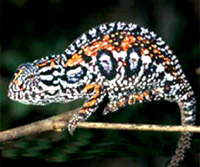
Carpet chameleon |
|
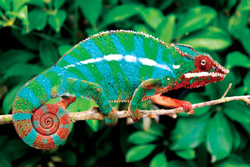
Panther chameleon |
However, contrary (opposed) to popular belief that chameleons change
colour to suit the environment, they do so only in response to
temperature, light and mood. They are naturally camouflaged to suit the
environment.
If you have ever observed chameleons, you sure would have been amazed
at the way they could change colour. How are they able to change colour?
It's really interesting, because so many factors play a role in helping
them change into various colours, such as brown, green, blue, yellow,
red, black or white.
Did you know that the chameleon's transparent skin has four layers
which work together to produce these various colours? Special cells
which are collectively called
chromatophores, are
present in layers under the transparent outer skin.
|
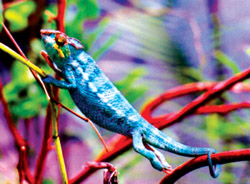
The prehensile tail is used like a limb |
|
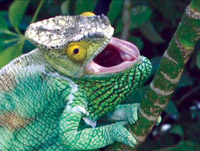
They have strong jaws |
The cells in the upper layer (xanthophorus or evythrophorus) contain
yellow and red pigment cells. The next layer called the iridophorus or
qudrophorus has a colourless crystalline substance called quanine.
These reflect, among others, the blue part of incident (naturally
attracting) light. If the upper layer of cells appear mainly yellow, the
reflective light becomes green (mix of blue and yellow).
A layer of dark melanin containing melanophorus is situated even
deeper under the reflective iridophorus. The melanophorus influences the
'lightness' of the reflective light, thus, different pigment cells can
relocate pigments rapidly, enabling the colour changes. Colour cells
alter size and change the amount of red, yellow and dark brown in the
layers.
|
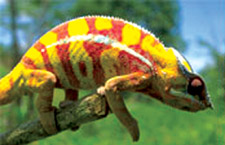
They live on trees |
|
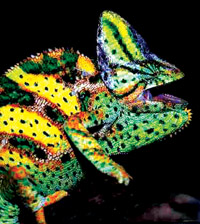
A veiled chameleon |
It is the levels of external light and heat, and the internal
chemical reactions that make the cells expand or contract enabling the
chameleon to wear different colours to suit its mood. For instance, a
calm chameleon may exhibit a green colour while an angry one may appear
yellow or even black in colour as some researchers claim.
Imagine how interesting it would be if we too could change our skin
colour like these bizaree lizards.
Before proceeding any further to examine the many striking features
of the chameleon, let's find out what their name means. Chameleons mean
'Earth lions' (perhaps by now you are trying to see the similarity to
lions). It comes from the Greek words chamai (on the ground, on the
earth) and leon (lion).
|
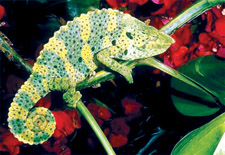
Males are more colourful. |
|

Tongue forms into a suction cup |
Members of the family Chamaeleontidae, they are descendants of an
ancient group of reptiles.
Chameleons vary in size and structure both, from species to species.
They belong to their own subfamily which is also divided into two tribes
; dwarf chameleons (Brookesiini) and typical chameleons (Chamaeleonini)
with about 134 species (34/100) so far identified in both tribes.
About five new species were discovered in the 90s alone. According to
researchers, almost half the world's chameleons live on the Island of
Madagascar. They claim that not only the largest, but also the most
unique species (numbering 59 species), exist only in this area.
Chameleons have many features that distinguish them from their lizard
cousins. They are the only lizards with zygodactyle feet. Now you are
bound to start wondering what this means. It means that the chameleons
have five toes on each foot - fused into a group of two and a group of
three, giving them a tongs-like appearance.
|

Chameleons have the longest and stickiest tongues of alll
lizards |
The toes are fused in front with two toes on the outside and three
inside, and in the reverse pattern on the hind feet. This type of feet
allow them to have a tight grip on the branches. As they have claws on
each toe, it is easy to find out how the toes are fused on each foot.
Chameleons also have head and facial ornamentation such as nasal
protrusions, horn-like projections or large crests on top of the head.
Usually, males are much more ornamented.
Their eyes too are very distinctive. Both the upper and lower eyelids
are joined with only a pinhole large enough for the pupil to see
through. They can rotate and focus the two eyes separately to observe
different objects simultaneously (at the same time), giving them a full
360 degree arc of vision around the body.
However, when prey is located, they focus both eyes in one direction
in order to get stereoscopic vision and depth perception. Have you heard
of the amazing tongue a chameleon has to help it catch prey which is far
away? Its tongue is incredibly long; longer than its body!
The chameleon is able to abruptly and rapidly extend its tongue out
of its mouth. In fact, it whips the tongue faster than the eye's speed,
at 26 body lengths per second. The tongue hits the prey in about one
tenth of an eye blink.
What really helps the chameleon to catch its prey is the sticky cup,
which is a bulbous (bulging) ball of muscle at the end of its tongue. As
the tongue hits the prey, it forms a suction cup, which makes the prey
stick to it. Then, the chameleon quickly draws the prey into the mouth
and crushes it with its powerful jaws.
Even a small chameleon can eat a large locust or mantis using its
powerful jaws. Apart from these two types of insects, chameleons feed on
crickets, grasshoppers, and other insects. Some larger species eat small
birds and lizards and even plant matter.
Now that we know about its feeding methods, let's see how they
communicate and respond to sound. It is said that like snakes,
chameleons have no outer ear. Then, how do they hear, or are they deaf,
you may wonder. Well, we know that snakes use a special bone (quadrate)
to transmit sound to the inner ear and perhaps, the chameleons do the
same.
It has been revealed that these creatures usually communicate through
colour changes and also through vibrations that travel through solid
material like branches, on which they spend lots of time.
Next time you spot a chameleon anywhere, do take time to observe this
amazing creature, especially as to how it changes colour and catches its
prey.
***
Fact file
* Chameleons have bodies that are flattened from side to side and are
shaped more or less like leaves.
* Their clawed feet have strong grasping power and work like the
hands of humans.
* Their bodies are generally in shades of brown or green, when at
rest.
* Ultraviolet Light (UL) is part of the chameleons' visible spectrum.
When they are exposed to UL, it is said that an increase in their social
behaviour and activity levels are shown; they are seen to be more
inclined to bask (lie) in the sunlight, feed and even reproduce.
* When hunting for prey, they remain still, almost like statues for
long periods of time.
* Veiled chameleons are one of about 80 species and are also called
the true chameleons. They are aggressive and brightly coloured. They
have a helmet like ridge on top of their heads which reaches a height of
about 5 cm.
When fully grown, bold bands of bright gold, green and blue, mixed
with yellow, orange or black circle the body. Males are normally
brighter and have skin in shades of green mottled with orange, white and
sometimes yellow and shaded tan. When threatened, they turn a darker
colour and 'play possum' (play dead).
* They inhabit all kinds of tropical and montane rainforests,
savannas and sometimes semi-deserts and steppes.
* Mostly arboreal, they are found in trees. Occasionally some smaller
species live on the ground, under the foliage.
* One species of chameleon, unique to Malawi's Mount Mulanje is
barely 0.6 in (1 cm) across when fully grown.
* At one time, people believed that chameleons never ate, but lived
on air. As a result, they were used as motifs to signify air.
* Females deposit parchment-shelled eggs in holes as deep as 4-12
inches, which they dig on the ground. The eggs are layed in clutches of
either 2-4 eggs or 80-100 eggs depending on the species. Sometimes, the
number of eggs vary even within the species.
* They live rarely more than four to five years.
* The tail is prehensile and used like a limb. It is about 12 cm (4.7
inc) long.
 |
